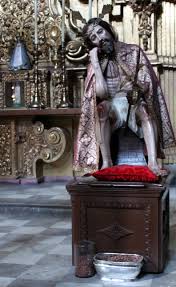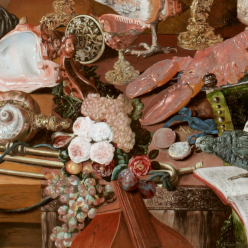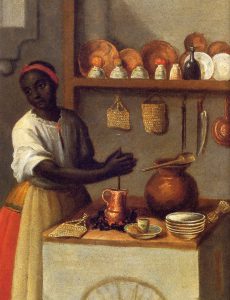
Unknown maker, Mexico City, c. 16th century.
Painted stone.
The Cathedral of Mexico City.
This statue features Jesus Christ holding a small cacao branch with gold leaves, from which it derives its name: Christ of Cacao. The statue, located in Mexico City’s cathedral, draws devotees from across the nation, many of whom leave offerings of chocolate at the base of the pedestal, as shown in the image. While this might seem like an odd donation to leave at Christ’s feet, chocolate has a long history of religious connotation in Central America.
Amerindians in Central America in the 15th century prized cacao as a currency because of the delicacy it produced—chocolate—and for its religious significance. They utilized it as currency because of its convenience: the beans were abundant enough that people had ready access to them, yet rare enough that they could act as a standard, much like gold does today. Up until the arrival of the Spanish, the Amerindians treated the cacao like money. The tribes who had more cacao trees on their land had greater weight with the other tribes because they had more money. When the Spanish arrived, the Europeans immediately strove to seize the cacao production and thus control the market.
The cacao’s product, chocolate, however, truly gave the bean special significance. The upper classes drank the hot drink at political banquets and during religious rituals; its presence was required during the signing of treaties. The Amerindians demanded chocolate’s appearance at these important events because they believed it had mystical powers.
The Popol Vuh is a Mayan epic that prominently features cacao. It tells the story of the maize god—the main Mayan god, whose crop provided their daily sustenance—whose skin is often depicted as being embedded with cacao pods. His journey requires him to spend time in the underworld, and when he emerges to the light once again, he comes through a grove of cacao trees, which often grew by the entrances to caves. For the Amerindians, then, the cacao was an important symbol of rebirth.
The Spanish, upon, their arrival, instantly recognized the similarities in the maize god’s journey and that of Christ, and manipulated those similarities to help spread Christianity and more easily control the local populace. They integrated the maize god’s story into Christ’s, forever connecting the two alongside the idea of cacao’s relationship with rebirth. This integration of religions came with numerous advantages for the Spanish. Specifically, it meant that when Amerindians left cacao offerings at the feet of statues of Jesus and saints, the priests could collect those offerings, amass them, and grow wealthy. Conquest for the Spanish came more easily when they could buy the people rather than fight them.
Thus Christ and cacao are forever intertwined in Central American history, and the statue of Christ holding cacao still draws offerings of chocolate today.
Sources:
Image: Unknown. c. 16th century. “El Señor del Cacao.” Mexico City, Cathedral of Mexico City. “Weaponizing Cacao.” Chocolate Class: Multimedia Essays on Chocolate, Culture, and the Politics of Food. (20 February 2015). Accessed 6 Dec. 2018. https://chocolateclass.wordpress.com/2015/02/20/weaponizing-cacao/
Aguilar-Moreno, Manuel. “The Good and Evil of Chocolate in Colonial Mexico” In Chocolate in Mesoamerica : A Cultural History of Cacao, edited by Cameron L. McNeil, 273-88. Gainesville: University Press of Florida, 2006. https://login.avoserv2.library.fordham.edu/login?url=http://search.ebscohost.com/login.aspx?direct=true&db=nlebk&AN=380221&site=eds-live.
Aliphat, Mario and Laura Caso Barrera. “The Itza Maya Control over Cacao” In Chocolate in Mesoamerica : A Cultural History of Cacao, edited by Cameron L. McNeil, 289-306. Gainesville: University Press of Florida, 2006. https://login.avoserv2.library.fordham.edu/login?url=http://search.ebscohost.com/login.aspx?direct=true&db=nlebk&AN=380221&site=eds-live.
Earle, Rebecca. The Body of the Conquistador: Food, Race and the Colonial Experience in Spanish America, 1492-1700. Cambridge, UK: Cambridge University Press, 2013.
Martin, Simon. “Cacao in Ancient Maya Religion” In Chocolate in Mesoamerica : A Cultural History of Cacao, edited by Cameron L. McNeil, 273-88. Gainesville: University Press of Florida, 2006. https://login.avoserv2.library.fordham.edu/login?url=http://search.ebscohost.com/login.aspx?direct=true&db=nlebk&AN=380221&site=eds-live.

